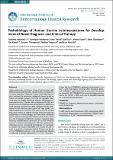Pathobiology of Human Uterine Leiomyosarcoma for Development of Novel Diagnosis and Clinical Therapy
Author(s)
Hayashi, Takuma; Ichimura, Tomoyuki; Kasai, Mari; Gur, Gal; Yaish, Pnina; Zharhary, Dorit; Kanai, Yae; Yaegashi, Nobuo; Konishi, Ikuo; Tonegawa, Susumu; ... Show more Show less
Downloadiaecr-3-010.pdf (575.2Kb)
PUBLISHER_CC
Publisher with Creative Commons License
Creative Commons Attribution
Terms of use
Metadata
Show full item recordAbstract
Uterine sarcomas comprise a group of rare tumours with differing tumour pathobiology, natural history and response to clinical treatment. Diagnosis is often made following surgical treatment for presumed malignant mesenchymal tumours and benign tumours. Currently pre-operative diagnosis does not reliably distinguish between malignant mesenchymal tumours, Uterine Leiomyosarcoma (U-LMS) and benign tumours including Leiomyomas (LMA). U-LMS is the most common sarcoma but other subtypes include endometrial stromal sarcoma (low grade and high grade), undifferentiated uterine sarcoma and adeno sarcoma. Clinical trials have shown no definite survival benefit for adjuvant radiotherapy or chemotherapy, and have been hampered by the rarity and heterogeneity of these tumour types. There is a role of adjuvant treatment in carefully selected cases following multidisciplinary discussion at U-LMS reference centres. In patients with metastatic LMS then systemic chemotherapy can be considered. Accordingly, it is necessary to analyse risk factors associated with human U-LMS, in order to establish a treatment method. Proteasome β-subunit 9 (PSMB9)/β1i-deficient mice spontaneously develop U-LMS, with a disease prevalence of ~37% by 12 months of age. We found PSMB9/β1i expression to be absent in human U-LMS, but present in human LMA. Therefore, defective PSMB9/β1i expression may be one of the risk factors for human U-LMS. PSMB9/β1i is a potential diagnostic-biomarker for human U-LMS, and may be targeted-molecule for a new therapeutic approach. Keywords: PSMB9/β1i; Diagnosis; Mesenchymal tumour; Leiomyosarcoma; Leiomyoma
Date issued
2017-09Department
Massachusetts Institute of Technology. Department of BiologyJournal
International Archives of Endocrinology Clinical Research
Publisher
ClinMed International Library
Citation
Hayashi, Takuma et al. “Pathobiology of Human Uterine Leiomyosarcoma for Development of Novel Diagnosis and Clinical Therapy.” International Archives of Endocrinology Clinical Research 3, 1 (December 2017): 10 © 2017 Hayashi T, et al
Version: Final published version
ISSN
2572-407X